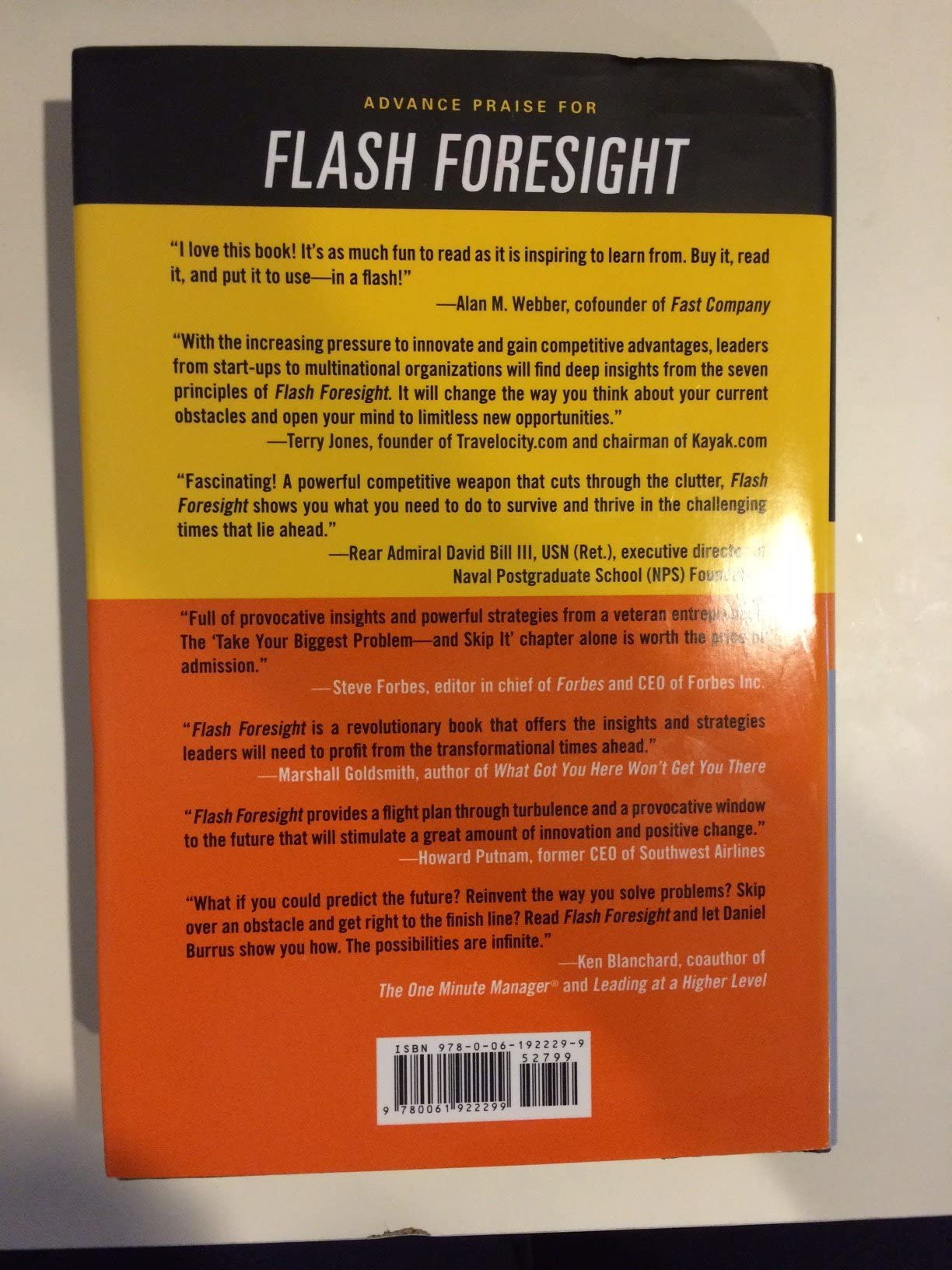





Business Flash Foresight: How to See the Invisible and Do the Impossible
R**Y
Loved the book
If you've seen Daniel Burrus speak and enjoyed this presentations, this book is a good choice. I ordered it after I saw him speak last year at a conference. If you're in the high-tech industry or a CEO of a company using technology this is a good read.
T**R
Five Stars
This is a must read for every professional
M**N
A lire
Excellente lecture. L'analyse de Daniel Burrus est pertinente et peut être projeté dans tous les domaines, y compris plus personnels.
W**E
Future Proof Your Life - Read This Book!
Brilliant book. Daniel is very clear and delivers a real sense of understanding and knowledge. His proven results in the 'real world' only compound this fact. Highly recommend.
D**N
The people who read this book will end up with your marketshare
.I read a lot of leadership books and you sometimes have to wade through a lot of mediocre books to get to a jewel. Flash Foresight is definitely a jewel. So good that I have sent it to clients and I will read it again.This book makes you think in the same manner that the essays in Malcolm Gladwell's "What the Dog Saw" makes you think. More importantly it provides a systematic approach to conquer the challenges addressed in the book.If I had to pick one phrase from the book that communicates its essence it would be what the author describes as the new golden rule of business "If it can be done, it will be done... If you don't do it, someone else will."The question that remains unanswered is "are you or your company that someone who will do it?" Will you have and act on the Flash Foresight as he defines it "a blinding flash of the future obvious."BOOK STRUCTUREThe author does a good job of summarizing the action steps from each chapter allowing the busy executive to quickly gather the content. Even though the summarized actions are well written, reading the entire chapter is still well worth it to get the context. Excellent use of examples from industry and the authors experience with references are provided when appropriate.The author provides a systematic approach with seven "foresight triggers" and eight "pathways of technological advancement." He develops this approach in a manner that facilitates execution of his process because he judiciously incorporates a common understanding of the terms and premises on which they are built. These include: cyclic change, linear change, soft trends, hard trends, the three digital accelerators, and transformation.PRACTICAL APPLICATIONIn order to gain "Flash Foresight" the author advocates spending an hour each week addressing "What are you certain about? What are the hard trends of your future, versus the soft trends? What are the permanent, linear changes and what are the cyclical changes? How are the three digital accelerators and eight pathways of technology driven transformation going to affect your life and work?...What are the problems you are going to have tomorrow, next week, next month? A few years down the road? What are the problems your kids, your spouse, your employees, your associates, your customers are going to have? Even better, what are the future problems of those people who are not yet your customers but will be if you have solutions to their problems by the time they happen?"INTERESTING POINTSHere are a few excerpts that resonated with me.1. "Either/or" thinking assumes a zero-sum game, in which the pie is fixed size and emerging technologies-or emerging markets-must necessarily threaten the existence of the old. But that's not reality...The principle of "both/and" tells us that the new and the old will continue to coexist side by side.2. ...one clear dependable strategy for staying ahead of the curve is to create in yourself and in your company or organization a habit of continuously decommoditizing. Anything and everything can become a commodity; and any product or service can be decommoditized. [Yes, he does provide examples]3. ...there will be no recovery, no going back-only a surge forward into a very different world.4. Not long ago, a CEO of a large company told me he was reluctant to spend the money to upgrade his people's skills. "What if I do," he said, "and then they leave?"..."I see your point," I responded. "But what if you don't-and then they stay?"5. ...The organizations that are succeeding today are those that have learned how to fail fast-and who do not fail to learn.6. Here is the question you need to ask yourself: "In order to speed up, am I willing to slow down?"CONCLUSIONThis book ends very powerfully with the author providing a real example of how he used the process from a blank slate to create a successful product with a minimum of overhead. This book not only will re-frame your thinking but you can use it as a tool to re-frame the thinking of those around you. This book is beyond a good idea, beyond an academic's theory... it is a practitioner's framework that can be built upon to drive personal and business success.Dr. James T. Brown, PMP PE CSPAuthor - The Handbook of Program Management
Trustpilot
3 weeks ago
1 week ago